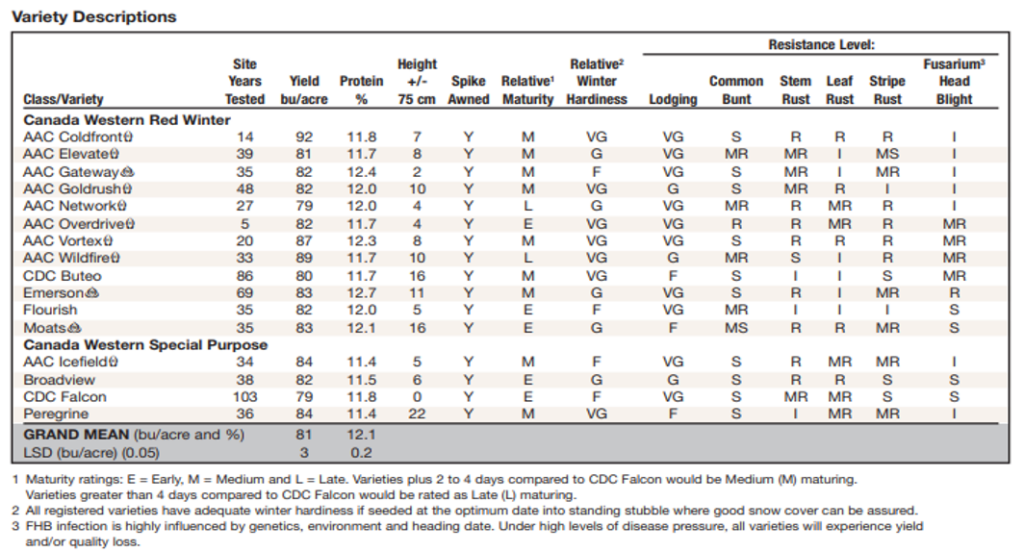Section Title
Planning for a Successful Winter Wheat Crop
- Winter Wheat
The key to winter wheat production is planning ahead. Early planning for your winter wheat crop can ensure your fields have suitable stubble and are ready for planting your winter wheat crop in the ideal seeding window.
Seeding
The ideal seeding window for winter wheat in Manitoba is early to mid-September. In northern regions of the province, the window is shorter, and farmers should aim to have their seed in the ground by Sept. 15. In southern Manitoba, the end of the ideal window is around Sept. 21. Seeding early promotes vigorous plant growth and improves the chance of winter survival. Wheat plants that begin winter with three leaves tend to have healthy, well-developed crowns. Winter wheat insurance information can be found here and here. Contact a MASC service centre for more information.
Table 1. Manitoba Agricultural Services Corporation (MASC) 2024 seeding date deadline for full and extended coverage for winter wheat.
| Crop | Seeding deadline | Extended Seeding Period |
| Winter wheat | Aug. 15 – Sept. 25 | Sept. 26 – 30 |
Farmers should generally target a plant stand of 20 to 30 plants per square foot. When calculating seeding rate, a seedling survival rate of 0.70 is used to account for germination and emergence, as well as the impact of winter survival. To calculate seeding rate in pounds per acre based on a desired plant population, use the following equation:

In the fall, many fields are depleted of soil moisture from the recently harvested crop. Winter wheat should be seeded shallow (half an inch to one inch) to take advantage of fall rains.
Field selection
It’s important to seed your winter wheat crop into standing stubble, as it will help trap snow to insulate the crown from harsh winter temperatures. For optimal winter survival, stubble should hold four inches of snow. Canola, barley, oat and flax stubble all have great snow-trapping capability. Bean, lentil, potato and pea stubble have poor snow-trapping ability. Wheat straw is not recommended due to disease concerns.
If canola is harvested late, barley and pea stubble are excellent alternatives as they are early harvested, allowing for early seeding and good crown development going into winter. Pea stubble has very low snow catch ability, caution should be taken in lower snowfall areas. Only use two-row barley stubble, as two-row barley loses its germination quickly over the winter. Therefore, there is less risk of volunteers come spring. Six-row barley can maintain its germination over the winter and become a volunteer weed issue.
Variety
There are many factors to consider when selecting a winter wheat variety for your operation, including winter hardiness, disease resistance, yield potential and lodging resistance. Many newer varieties have an improved disease, yield and winter hardiness packages. There is also good levels of seed supply for these newer varieties, making them a good choice for Manitoba growers.
Table 2. Winter wheat varietal descriptions from Seed Manitoba.
Table 3. Top six Canada Western Red Winter varieties from MASC’s Variety Market Share Report.
| Variety | Relative Acreage (%) * |
| AAC Wildfire | 43.2 |
| Emerson | 22.2 |
| AAC Goldrush | 12.5 |
| AAC Gateway | 5.8 |
| AAC Elevate | 5.2 |
| AAC Vortex | 4.4 |
*Data obtained from MASC 2023 Variety Market Share Report
Fertility
Any field operations that break down stubble, such as fall fertilizer application, can negatively impact snow-trapping potential. If there is any concern that you may not be able to get into the field in the spring for a split nitrogen (N) application, it is better to give your winter wheat its full fertility regimen at planting, as long as it’s not all with the seed. Soil tests are recommended to aid in fertility decisions. If soil tests are not available, the following are general fertility recommendations:
- Nitrogen:
- 80 to 120 pounds per acre. If applying in the spring, N in nitrate form is the most readily available form, so dribble-banded UAN (28-0-0) is a good choice. Enhanced efficiency N (controlled release or nitrification inhibitors) can be effective if fall application is desired.
- Placing more than 30lb/ac in the seed row can be detrimental to seedling development and increase winter injury.
- Phosphate: 30 to 40 pounds per acre. Place all phosphorus (P) in the seed row. Inadequate P levels can reduce winter survival.
- Potassium: 15 to 30 pounds per acre on sandy or organic soils.
- Sulphur: 15 pounds per acre of sulphate sulphur, only when sulphur levels are low.
For more information on fertility recommendations in Manitoba, click here. Stay tuned for updated information on soil nitrogen recommendation from MCA-funded research!
Additional Resources
Manitoba Agriculture
Manitoba Crop Alliance
Common Questions
Q: I’d like to seed my winter wheat into barley stubble as my canola is late this year, what should I be taking into consideration?
A: There are a couple things to keep in mind when planning to seed your winter wheat into cereal stubble:
- Seeding issues: This used to be more of a concern due to the amount of straw and chaff cereals produce. However, newer combines do a better job of chopping and spreading residue and many farmers have had good results seeding their winter wheat into barley stubble.
- Diseases: Of course, seeding a cereal into cereal residue can cause disease issues. Many of these concerns can be mitigated with use of seed treatments and fungicides. However, wheat streak mosaic is a viral disease transmitted by leaf curl mite, which requires a green (living) host to survive. If winter wheat establishes where the previous cereal crop was infected and the previous crop still has green tissue, a “green bridge” is created that allows the mite to move from the previous crop to the winter wheat. Since there is no chemical control, it is best to allow seven to 10 days between the dry down of the previous cereal crop and emergence of the winter wheat crop. There are also winter wheat varieties such as Elevate that have good resistance to wheat curl mite.
Q: Last year, I side banded ESN in the fall and put additional UAN on as soon as I could in the spring. What are your thoughts on putting ESN with the seed?
A: There is a risk of injury when you place any fertilizer with the seed. This year, some unexpected injury was observed with ESN, even though research out of Alberta has shown ESN to be up to three times safer than urea. See the chart below to come up with a “safe rate.” Keep in mind that under dry conditions and narrow row openers, risk of injury may still be high. In general, if you have the equipment, it is likely best to stick with the safe, side-banded option.
Table 4. Rates of urea nitrogen (lb N/ac) safely applied with cereal and canola seed if seedbed soil moisture is good to excellent. Where seedbed moisture is low or when weather is hot and windy, reduce these rates by approximately 50 per cent.

1 Width of spread varies with air flow, soil type, moisture level, amount of surface crop residue and other soil conditions, so it must be checked under field conditions.
2 Some openers give less than 1” spread. Urea should not be applied with the seed on light soils when a double disc opener is being used.
* SBU, seedbed utilization, is the amount of the seedbed over which the fertilizer has been spread. Thus, it is a reflection of the relative concentration of fertilizer. SBU (%) is the width of spread, divided by the row spacing, multiplied by 100. For example, if the seeding implement has a 6” spacing and spreads the seed and fertilizer over 2”, the SBU would be 33 per cent (2/6 X 100 = 33). The higher the SBU, the more fertilizer that can be safely spread with the seed. Although some openers spread the seed and fertilizer vertically, SBU does not take this into account since it is generally recognized that all seed should be placed at an even depth for even germination and emergence.
Q: After the wet spring I have some unseeded acres that I’d like to get something growing on. Knowing there is no stubble for snow catch, how can I maximize the chance of successful overwintering?
A: Seeding into fallow ground is risky, but can to help dry out the soil. Here are some things that you can do to help the field overwinter successfully:
- Variety Selection: Choose a variety with very good winter hardiness. Previously good winter hardiness was a concern for winter wheat, but since 2015 five newer varieties are rated ‘Very Good” for winter hardiness. Any of Wildfire, Goldrush, Vortex, Coldfront or Overdrive are the best options.
- Seed Early: Since you don’t have to wait for harvest before seeding, getting onto the field early helps make a big healthy crown with more reserves to survive the winter. Seeding too early coupled with a longer warm fall can make the crown too large and more susceptible to freezing injury or snow mould. Ideally, seeding between Aug. 25-Sept. 5 is a good happy medium.
- Fertility: Unseeded acres will have undergone a lot of mineralization over the growing season, and as a result will have higher levels of available nitrogen. Soil test to know what application rates are recommended. Fall nitrogen application usually not needed but spring top up is still required. Still apply phosphorus close to the seed at seeding, as this will help improve winter survival.









